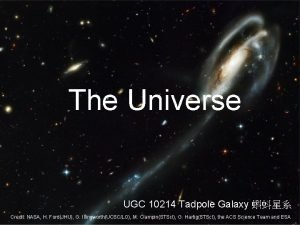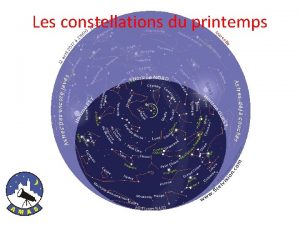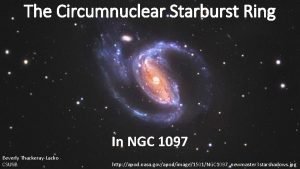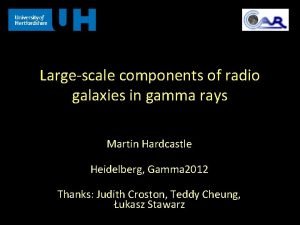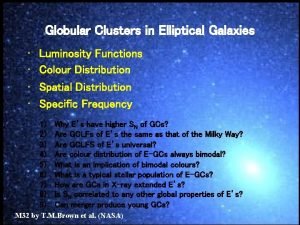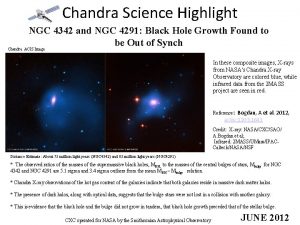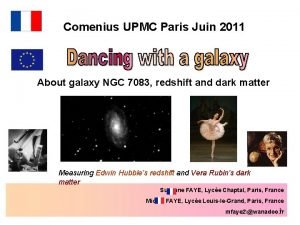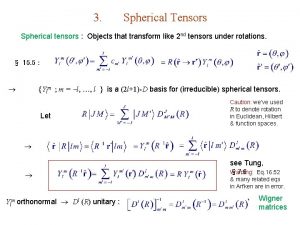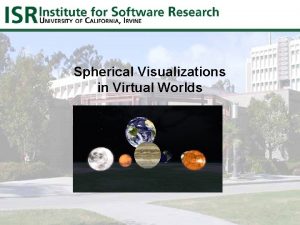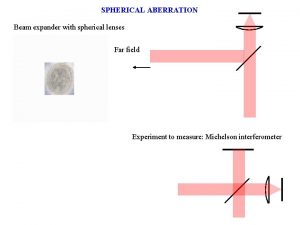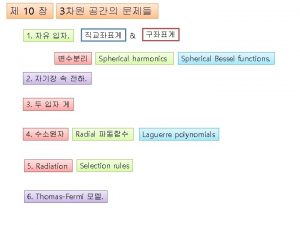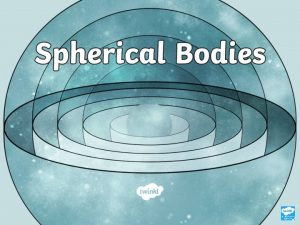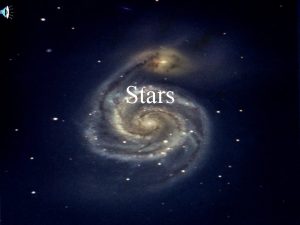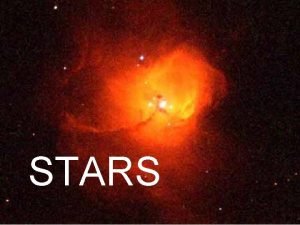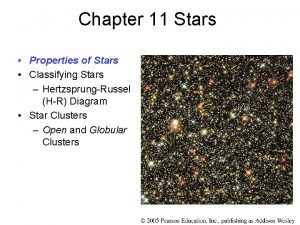Stars NGC 3603 What is a Star Spherical




















- Slides: 20

Stars


NGC 3603

What is a Star? • Spherical “ball” of glowing gases • Produces/produced its own energy through nuclear FUSION reactions • Typical composition – ~75% Hydrogen – ~25% Helium – <1% other elements

Stable Lifetime © Eric Chaisson • Stars exist because of gravity • They remain stable only by maintaining great pressures in their interiors. • Gravity acts to make it contract, pressure pushes back to balance the gravity • Stars are battlefields between gravity and pressure, and gravity ALWAYS wins in the end

Star Birth • Where astronomers find the youngest stars, they also find molecular clouds • Molecular clouds are typically: – Composed of H, He, simple molecules, and “dust” – huge - may have enough matter to form 100, 000 stars the size of the Sun – Cold, about 10 K (10 degrees above absolute zero)

• A passing shock wave triggers a part of a cloud to begin to contract From • Shock waves come from four processes: – Nearby supernovae – Ignition of a nearby star – Collision between molecular clouds – Rotation of a galaxy As the cloud contracts atoms gather speed as they fall in a stage called free-fall contraction • Gravitational energy is converted into thermal energy and the gas grows hotter • if temperatures reach about 7 million K, nuclear fusion starts • A star is born Nebula to Star

Star Formation Video

Distances to Stars • • • The closest star to the Sun is Proxima Centauri, 4. 3 lightyears away one way to determine distances to stars is to use parallax measure the angular shift in the star's position 6 months apart Using a little geometry you can calculate the distance angles get too small to measure for stars more than about 150 lightyears away

What Process Could You use to Calculate Distance Using Parallax? • Establish where you can find a right triangle when using parallax. • What is the length of the base (short side) of the triangle? • Which trigonometric function would you use? • Construct a formula for getting the distance including both of the components above.

Some “Nearby” Stars Name • Proxima Centauri • Alpha Centauri A • Alpha Centauri B • Barnard’s Star • Wolf 359 • BD +36 2147 • Luyten 726 -8 A • Luyten 726 -8 B • Sirius A • Sirius B Dist (ly) 4. 2 ly 4. 3 6. 0 7. 7 8. 2 8. 4 8. 6 mag 11. 05 -0. 01 1. 33 9. 5 13. 5 7. 5 12. 5 13 -1. 46 8. 3 Mag 15. 5 4. 4 5. 7 13. 2 16. 7 10. 5 15. 5 16 1. 4 11. 2

Star Brightnesses - the Magnitude Scale • Introduced by Hipparchos (160 - 127 BC) – brightest stars were 1 st magnitude – faintest stars were 6 th magnitude (unaided eye) – larger the magnitude, the fainter the star! • Today it is similar, but more mathematical - logarithmic – 1 st magnitude stars are 100 x brighter than 6 th magnitude stars – 1 magnitude difference = 2. 512 x difference in brightness

Star Brightnesses - the Magnitude Scale • Magnitude scale has been extended to all astronomical objects • formalizing the mathematics has produced stars with negative magnitudes (Sirius = -1. 42)

More About Magnitudes • The brightness of stars is affected by two factors: – Intrinsic brightness - how bright the star really is – How far away it is • To deal with this, astronomers use two types of magnitudes: – Apparent magnitude – how bright a star appears – Ex: Sun: mag -26. 5, Sirius: mag -1. 44 – Absolute magnitude – how bright a star really is: – Ex: Sun: Mag 4. 8, Sirius: Mag 1. 45

Star Names • The "common" names derive from ancient Arabic, and often have meanings • in 1603, the first "modern" naming system was developed by Johann Bayer, using: – the Greek alphabet to indicate the apparent brightness of the star – the Latin name of the constellation – EX: the brightest star in Orion (Betelguese) is also called a Orionis, the 2 nd brightest, is called b Orionis – one problem with this system is that some stars vary in brightness – the alpha star may not always be the brightest • There are over 10 different systems that are/have been used for naming stars • NO COMMERCIAL, FOR-PROFIT, STAR-NAMING SERVICE HAS ANY OFFICIAL STAR-NAMING RIGHTS

Sizes of Stars • Stars come in all different sizes, depending on their mass and their age • Masses range from 1/25 the mass of the Sun to maybe 200 x mass of the Sun • largest known star is VY Canis Majoris, which would extend nearly to Saturn

• Stars produce energy through nuclear fusion. • Convert Hydrogen to Helium Sun and smaller stars • Proton-proton chain • 4 H He • Requires temps of 10 million K & high densities • The Sun converts about 600 million tons of H to 596 million tons of He every second. • The “missing” 4 - 5 million tons of mass is converted into energy: • E = mc 2 Energy Production

Energy Production Stars larger than the Sun (1. 1 x larger) • Use CNO cycle • Convert Hydrogen to Helium, using Carbon, Nitrogen, and Oxygen • End result is the same, 4 H+ He • Requires temps = 16 million K and higher

Life Expectancy of Stars • The biggest stars have the shortest lives – maybe “only” 20 million years. • While they have a large amount of fuel, they use it very quickly. • Average stars like our Sun, shine for about 10 billion years. • The smallest stars live the longest lives, maybe a trillion years!

The Beginning of the End • When the Hydrogen in the core is “used up”, the forces of _____ and _____ become unbalanced, and the star becomes unstable. • Energy production slows, internal pressure decreases. • Gravity causes star to shrink, increasing the temperatures. • New nuclear reactions start in the core, Helium is converted to Carbon. • Star expands, its surface cools, becoming a red giant.
 Bearing gifts we traverse afar
Bearing gifts we traverse afar There are millions of stars in the space
There are millions of stars in the space Bn tinh l?n ngc
Bn tinh l?n ngc Ngc 3393
Ngc 3393 Photo credit
Photo credit Ngc 6251
Ngc 6251 Ngc 4303
Ngc 4303 Magnitud aparente
Magnitud aparente Ngc 4945
Ngc 4945 Ngc 1097
Ngc 1097 Inverse compton
Inverse compton Ngc protein purification
Ngc protein purification Ngc 6050
Ngc 6050 Ngc 2147 galaxy classification
Ngc 2147 galaxy classification Ngc 4291
Ngc 4291 Ngc 4414
Ngc 4414 Ngc 4261
Ngc 4261 Ngc 7083
Ngc 7083 A* algorithm and ao* algorithm
A* algorithm and ao* algorithm Fccla star stands for
Fccla star stands for A flat smooth mirror
A flat smooth mirror




